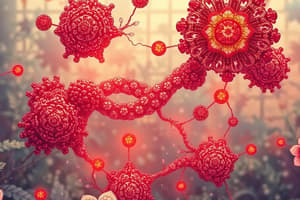Podcast
Questions and Answers
Enzymes are classified according to the chemical ______ they catalyse.
Enzymes are classified according to the chemical ______ they catalyse.
reactions
The optimum ______ is the point when the rate of reaction is highest and the enzyme is most active.
The optimum ______ is the point when the rate of reaction is highest and the enzyme is most active.
temperature
Enzymes are proteins that function as biological ______.
Enzymes are proteins that function as biological ______.
catalysts
Enzymes work by lowering the ______ energy of a reaction.
Enzymes work by lowering the ______ energy of a reaction.
The 'lock-and-key' hypothesis explains enzyme ______.
The 'lock-and-key' hypothesis explains enzyme ______.
When all the active sites of enzyme molecules are saturated the rate of reaction will remain ______.
When all the active sites of enzyme molecules are saturated the rate of reaction will remain ______.
The name of an enzyme shows the substance on which the enzyme acts on ends in '______'.
The name of an enzyme shows the substance on which the enzyme acts on ends in '______'.
An increase in substrate concentration means an increase in the number of ______ molecules available.
An increase in substrate concentration means an increase in the number of ______ molecules available.
At low temperature, the enzymes are ______.
At low temperature, the enzymes are ______.
Biological washing powders contain protease and ______ to remove protein stains and fat/grease from clothes.
Biological washing powders contain protease and ______ to remove protein stains and fat/grease from clothes.
Polypeptide chains of enzyme molecules ______ as ionic forces of attraction increase too much .
Polypeptide chains of enzyme molecules ______ as ionic forces of attraction increase too much .
Increasing the temperature increases the rate of enzyme reactions until the ______ temperature is reached.
Increasing the temperature increases the rate of enzyme reactions until the ______ temperature is reached.
When the active site loses its specific three-dimensional ______ the enzyme reaction will be impacted.
When the active site loses its specific three-dimensional ______ the enzyme reaction will be impacted.
A competitive inhibitor is structurally similar to the ______ of the enzyme that it inhibits.
A competitive inhibitor is structurally similar to the ______ of the enzyme that it inhibits.
When an enzyme is ______, there is loss or change in the active site.
When an enzyme is ______, there is loss or change in the active site.
The substrate binds to the enzyme, forming an enzyme ______ complex.
The substrate binds to the enzyme, forming an enzyme ______ complex.
A ______ is a molecule that inhabits the action of specific enzymes.
A ______ is a molecule that inhabits the action of specific enzymes.
In the presence of a non-competitive inhibitor, increasing the substrate concentration ______ prevent the inhibitor to the same enzyme.
In the presence of a non-competitive inhibitor, increasing the substrate concentration ______ prevent the inhibitor to the same enzyme.
When pH changes drastically, polypeptide chains of enzyme molecules unfold as ionic forces of attraction holding the chains together are ______.
When pH changes drastically, polypeptide chains of enzyme molecules unfold as ionic forces of attraction holding the chains together are ______.
Enzymes catalyse or speed up the rate of chemical ______ and remain chemically unchanged at the end of the reaction.
Enzymes catalyse or speed up the rate of chemical ______ and remain chemically unchanged at the end of the reaction.
Flashcards
What are Enzymes?
What are Enzymes?
Proteins functioning as biological catalysts.
What is Activation Energy?
What is Activation Energy?
The minimum energy reactants need to react.
What is a Substrate?
What is a Substrate?
A substance on which an enzyme acts.
What is the 'Lock-and-Key' Hypothesis?
What is the 'Lock-and-Key' Hypothesis?
Signup and view all the flashcards
What is the Active Site?
What is the Active Site?
Signup and view all the flashcards
What is Optimum Temperature?
What is Optimum Temperature?
Signup and view all the flashcards
What is Enzyme Denaturation?
What is Enzyme Denaturation?
Signup and view all the flashcards
What is Optimum pH?
What is Optimum pH?
Signup and view all the flashcards
What is Vmax (maximum rate)?
What is Vmax (maximum rate)?
Signup and view all the flashcards
What is a Competitive Inhibitor?
What is a Competitive Inhibitor?
Signup and view all the flashcards
What is a Non-Competitive Inhibitor?
What is a Non-Competitive Inhibitor?
Signup and view all the flashcards
What is a Biological Catalyst?
What is a Biological Catalyst?
Signup and view all the flashcards
What is Rate of Reaction?
What is Rate of Reaction?
Signup and view all the flashcards
What is Enzyme Specificity?
What is Enzyme Specificity?
Signup and view all the flashcards
What is a Protease?
What is a Protease?
Signup and view all the flashcards
What is a Lipase?
What is a Lipase?
Signup and view all the flashcards
What is a Carbohydrase?
What is a Carbohydrase?
Signup and view all the flashcards
Study Notes
Enzymes - General Info
- Enzymes are proteins functioning as biological catalysts
- Enzymes speed up chemical reactions without being chemically changed
- Only small quantities of enzymes are needed to catalyze reactions
- Enzymes reduce the activation energy (Ea) required for reactions to occur
Enzyme Functions
- Enzymes aid in digesting large food molecules into smaller molecules
- Enzymes help break down food to release energy in cellular respiration
- Enzymes assist with building complex molecules from simple substances: protein synthesis and photosynthesis
- Breaking down toxic substances in cells
Enzyme Nomenclature
- Enzyme names usually end in "-ase"
- The first part of the name refers to the substrate that the enzyme acts on
- Maltase is an enzyme that breaks down maltose
Enzyme Classification
- Enzymes are grouped based on the type of reactions they catalyze
- Hydrolases catalyze hydrolytic reactions (digestive enzymes)
- Proteases digest proteins
- Lipases digest lipids
Substrate Specificity
- Substrate is the substance upon which an enzyme acts
- Substrates bind to the enzyme's active site, typically a depression or "pocket"
- According to the "lock-and-key" hypothesis, enzymes are specific due to the shape of their active site
- The enzyme ("lock") has an active site with a specific three-dimensional shape
- Only a substrate ("key") with a complementary shape fits inside
- This forms an enzyme-substrate complex
- After the chemical reaction, the substrate is converted into products
- Products then detach from the active site
- The enzyme's active site is then free to bind another substrate molecule
- Enzymes can be reused over and over again and are required in only small amounts
- At the end of the reaction, the enzyme is unchanged
Studying That Suits You
Use AI to generate personalized quizzes and flashcards to suit your learning preferences.




